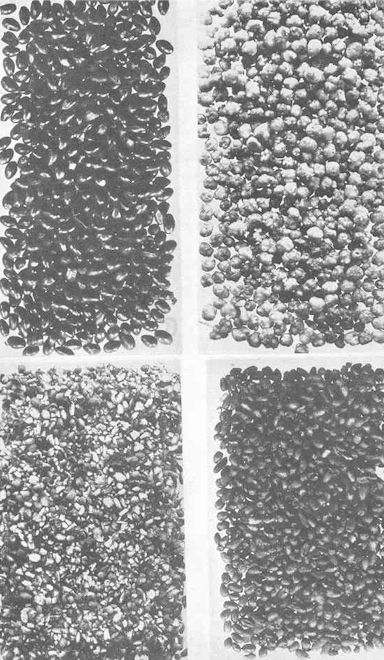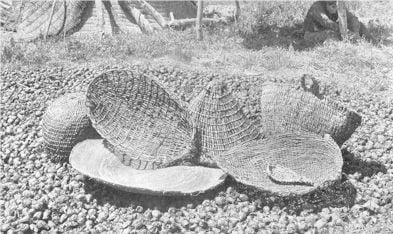In the preparation of shnaps from shelled wokas, kernels, or lolensh, the primitive method of roasting with live coals in a wokas shaker, as described under shiwulinz, seems to have been entirely discarded. The frying pan is now used instead by all the Indians. A handful or two of lolensh, either the fresh or the dried and stored product, about enough to barely cover the bottom, is thrown into a hot frying pan and roasted briskly over a fire until it is nicely parched and slightly browned, the pan being shaken meanwhile to prevent scorching. The kernels swell, crack their coats, and roll over like animate objects, but do not explode like popcorn. When the parching is completed the grains are roughly spherical, with a tuberculate surface, and the bulk of a mass of the kernels has increased two and one third to three times. A thick-bottomed cast-iron frying pan is much better for parching wokas than a thin-bottomed one of pressed steel, a much more even and not extremely high temperature being thus secured.

The parched wokas, or shanks, has a delicious flavor, somewhat similar to that of popcorn or, more especially, parched corn. When freshly parched it is more crisp and appetizing, and doubtless more fully digestible, than after it has been allowed to stand in a humid atmosphere and absorb moisture.
Shanks is often eaten dry, and in this state it is most palatable to white people, but ordinarily the Indian places it in a dish and pours over it barely enough cold water to cover it. It is then eaten with a spoon, with or without salt, a modern innovation. Sometimes the shanks is finely ground before the addition of the water, and the preparation is then known as shlotish (shlo-tish’). In primitive times the Klamaths used for eating wokas a spoon cut from the breast bone of the swan, which is conveniently shaped for the purpose. Their name for such a spoon is sh’-o-kobh’.
Lowak
The nearly mature but still had wokas pods that make up the print are ordinarily spread upon the ground to dry, in flat-topped piles about 8 inches thick. Each day the margin of the pile is added to as new polo are brought in from the marsh. The bright sunshine prevalent at the time of the wokas harvest hastens the drying, thick and mucilaginous as the pods are, and in from one to two weeks those on the surface and margins of the piles are thoroughly dry. The pods thus dried are placed on a mat or piece of gunny sack and pounded with a stone or short pestle (skâ). The seeds are thoroughly dry and drop out easily, and when the mass is sufficiently pounded portions of it are placed on a shaker and the light corky or pithy pieces of the pods are winnowed out. Some of the women, before winnowing the seed on a shaker, separate the coarser pieces of waste matter by running the whole mass through a coarse wicker sifter (ti-a’). Seeds thus prepared from dried pods and still covered by their shells are known as lo-wak’. They are commonly stored in sacks for winter use. The screenings as (kakt-chi-as) from lowak, though made up mostly of the light corky pieces of the dry body of the pods, do contain a small percentage of seeds. They were sometimes stored, in the old days, for use in case of famine.



